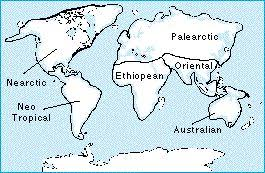Science > Biology > General Biology > Diversity of Living Organisms > Biodiversity
Scientists have identified and named 1.7 to 1.8 million species of living organisms. Of these, about 1.2 million are animal species while 0.5 million are plant species. The group of insects is the largest group with 1.025 million species. According to biologists some 5 to 30 million species of organisms exist on the earth. The variety that we see in the living things that exist on the earth is called biological diversity or biodiversity. There is variety in their shapes, sizes, bodies apart and lifespan. The term biological diversity (or Biodiversity) was coined by Walter G. Rosen in 1986. The term biodiversity includes diversity within species, between species and of ecosystems.
Types of Species Diversity:
Genetic Diversity:
Genes give specific characteristics to an individual. Each member of any animal or plant species differs from other individuals in its genetic material because of a large number of possible combinations in the genes. Due to this genetic variability, a healthy breeding population of a species is assured.
The diversity in wild species forms the ‘gene pool’ from which our crops and domestic animals have been developed over thousands of years. Using this gene pool new varieties of more productive and diseases resistant crops are obtained. Similarly, the breed of better domestic animals is obtained. In modern biotechnology and genetic engineering techniques, genes are manipulated for developing better types of medicines and a variety of industrial products.
Species Diversity:
The numbers of species of plants and animals that are present in a region constitute its species diversity. This diversity can be observed both in natural ecosystems and in agricultural ecosystems. Natural tropical forests have much greater species richness than plantations. A natural forest ecosystem provides fruit, fuelwood, fodder, fiber, gum, resin and medicines to local people. Areas that are rich in species diversity are called ‘hot spots’ of diversity.
Ecosystem or Community Diversity:
There are a large variety of different ecosystems on earth, Ecosystem diversity can be described for a specific geographical region. Distinctive land ecosystems include landscapes such as forests, grasslands, deserts, mountains, etc. Aquatic ecosystems include rivers, lakes, and the sea. Due to overuse or misuse productivity of the ecosystem is decreases and the ecosystem becomes degraded.
Types of Ecosystem Community Diversity:
R.H. Whittaker proposed a four-level of diversity.
- Point Diversity: This is the diversity on the smallest scale. It is diversity in microhabitat.
- Alpha Diversity: It is diversity over the comparatively larger area. It is also called local diversity. It includes a variety of living organisms occurring in a particular habitat. It is usually expressed by the number of species in that ecosystem. This is measured by counting the number of taxa (distinct groups of organisms) within the ecosystem.
- Gamma Diversity: It is diversity over larger areas or regions such as islands or landscapes. It is a measure of the overall diversity of the different ecosystems (alpha diversity) within a region. It is the inclusive diversity of all the habitat types within an area (region).
- Epsilon Diversity: The epsilon or regional diversity is defined as the total diversity of a group of areas of gamma diversity.
- Explanation:
- A single plant can be considered as an example of a unit of alpha diversity, then a leaf of a plant can be considered as point diversity. The group of plants together in a region can be considered as gamma diversity. The forest in which this region is located can be considered as epsilon diversity.
Mathematical Approach Towards Biodiversity:
Beta Diversity:
R.H. Whittaker defined it as “the extent of change in community composition, or degree of community differentiation, in relation to a complex-gradient of the environment, or a pattern of environments”. Beta diversity is defined as the ratio between gamma (regional) and alpha (local) diversities. Beta diversity does not only account for the relationship between local and regional diversity but also informs about the degree of differentiation among biological communities. It is a bridge from the alpha (local) diversity to the gamma (regional) diversity.
Delta Diversity:
Delta diversity is defined as the change in species composition and abundance between areas of gamma diversity, which occur within an area of epsilon diversity. It shows differentiation diversity over wide geographic areas.
Region of Mega Diversity:
The entire world is divided into six biogeographic regions. They are Palearctic (Europe and Asia), Nearctic (North America), Neotropical (Mexico, Central, and South America), Ethiopian (Africa), Indian (Southeast Asia, Indonesia) and Australian (Australia and New Guinea). The organisms found in these regions are adapted to the climate of these regions. Certain kinds of organisms are common to all regions while some are restricted to certain regions only. e.g. elephants are found only in Asia and Africa and nowhere else in the world. The grass is found all over the world.

The warm and humid tropical regions of the earth between the tropic of Cancer and Tropic of Capricorn, are rich in diversity of life i.e. plants, animals, and microorganisms. This region is called the region of mega diversity.
More than half of the biodiversities of the world are concentrated in 12 countries. They are Brazil, Colombia, Ecuador, Peru, Mexico, Zaire, Madagascar, Australia, China, India, Indonesia, and Malaysia.
‘Hotspots’ are regions of the world where many different kinds of organisms live. Many of these organisms are not found elsewhere e.g. many species of frogs live only in the Western Ghats of India. India has two biodiversities ‘hotspots’. The Western Ghats and North Eastern regions (including Eastern Himalayas).
The Uniqueness of Indian Biodiversity:
India is one of the 12 mega diversity countries in the world. India is divided into 10 biogeographical regions. India has a variety of physical features and climatic conditions. India has forests, grasslands, deserts, rivers, wetlands, coastal and marine regions which act as ecosystem and habitat for a variety of animals. Hence India has a great biodiversity.
Previous Page: Characteristics of life
Next Topic: Basis of Biodiversity